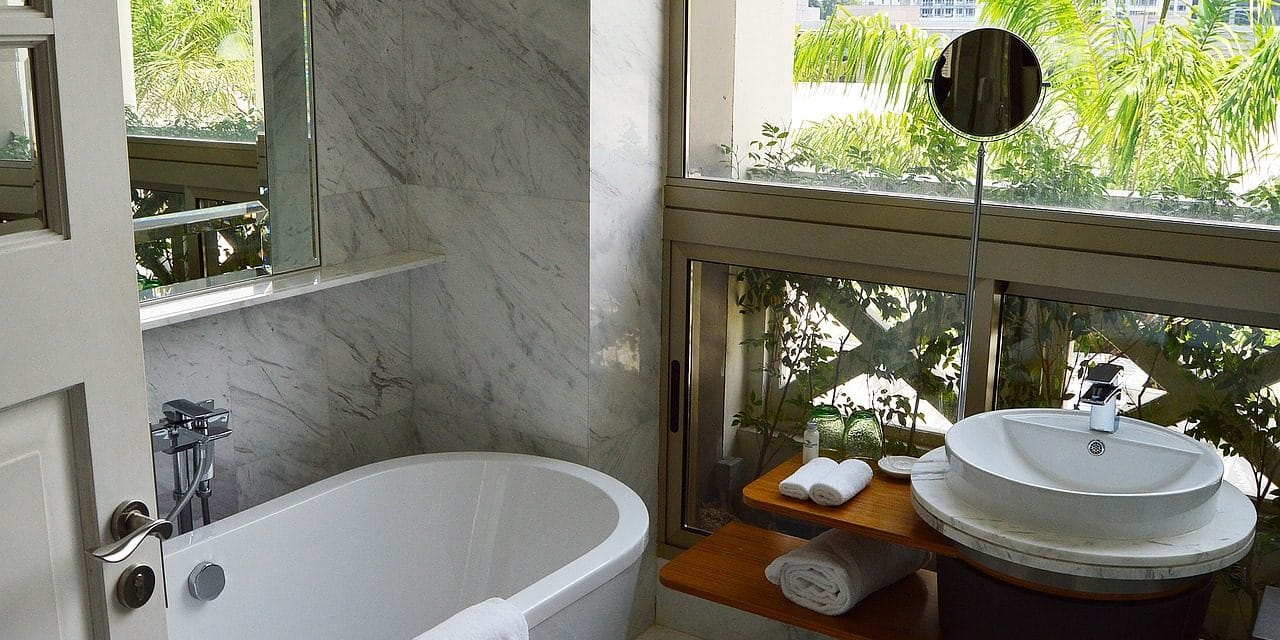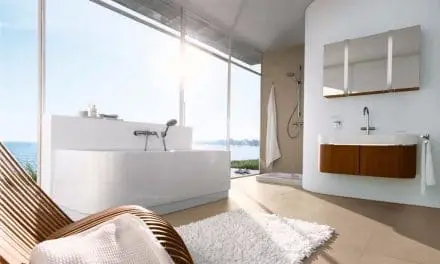An outdated bathroom can be one of the most aesthetically displeasing rooms in the home. Unlike a bedroom where a new coat of paint can transform the room in a day, a bathroom remodel could require a plumber, a tile installer, a carpenter, and an electrician as well. Because of the cost and complexity, the bathroom is often low on the list for getting refreshed. An outdated bathroom is not only hard on the eyes though, it also wastes a significant amount of water, uses more energy than necessary, and can give your home less than stellar indoor air quality. There have been incredible innovations in bathroom fixtures since the days of pink toilets, which means a bathroom remodel can drastically reduce your eco-footprint – and reduce your utility bills, as well. With so many things to consider, it can seem overwhelming, so here’s a checklist for an eco-friendly bathroom remodel to ensure that when you tackle this project, it gets done right.
#1 Find an eco-expert contractor.
Finding someone with previous experience in eco-friendly renovations is very important. You’ll save yourself a lot of time, headaches, and money by choosing someone who’s familiar with the sorts of products that are going to reduce your energy and water use and reduce your exposure to risky chemicals. A good place to find green building professionals is at The Green Home Guide website. Their ‘Find a Pro’ section has over seventeen thousand companies from all over the U.S. If you have a store in your area that sells eco-friendly building materials, ask if they have any local contractor’s business cards. Meet with a few different companies before choosing one. You and the contractor are going to go through a lot together, so you need to feel like your personalities, vision for the project, and passion for the environment mesh well.
#2 Pick water-wise fixtures.
Toilets
According to the EPA, a conventional toilet uses 1.6 gallons per flush, but that old pink one could be using between 3.5 to 7 gallons per flush. A leaky toilet can waste up to 200 gallons per day! One of the most popular toilets for eco-minded folk is a dual flush toilet is the best for water conservation. The dual flush gives you the option of using 1.6 gallons for a flush or about half of that if you’re only dealing with liquid waste. Some of these toilets have vacuum technology for a powerful flush that reduces water use even more. There’s even a type of toilet with a sink mounted over the tank, so the water you use to wash your hands is what’s used for flushing next time around! Whatever you choose, look for the EPA’s WaterSense label to ensure the product lives up to its claims.
Showerheads
A standard showerhead uses 2.5 gallons of water a minute and if it’s older than 1992, it could have a flow rate of up to 5.5 gallons per minute. To check the flow rate of your showerhead, mark a bucket with gallon lines and put it in the shower. Turn on the water and keep it on for just one minute. The amount of water that accumulates in the bucket in one minute is your flow rate. When you’re buying new, look for a low-flow showerhead. There are two types: laminar flow and aerating. The aerating type mixes air with the water creating a misty spray. The laminar-flow type pushes the water into individual streams. And, have no fear, neither sacrifice performance. There are also other innovative shower technologies that have recently hit the market – like a shower that recycles the water you’re using. With this technology, whether you take a 5-minute or a 50-minute shower, you’ll use the same amount of water, reducing your use up to 90 percent! Once again, look for the EPA’s WaterSense label.
Faucets
WaterSense labeled bathroom sink faucets use a maximum of 1.5 gallons per minute, reducing water use by 30 percent or more from the standard flow of 2.2 gallons per minute – without sacrificing performance. Add an aerator to curb the water flow to only 0.5 gallons per minute.
Greywater Systems
What’s greywater? According to Greywater Action: “Greywater is gently used water from your bathroom sinks, showers, tubs, and washing machines. It is not water that has come into contact with feces, either from the toilet or from washing diapers. Greywater may contain traces of dirt, food, grease, hair, and certain household cleaning products. While greywater may look “dirty,” it is a safe and even beneficial source of irrigation water in a yard.” About one-third of residential water use is for watering yards and gardens – amounting to over 7 billion gallons each day in the U.S. And, sadly, as much as 50 percent is wasted due to inefficient watering methods. Set up smart irrigation and pipe your greywater out of the house to maintain a green yard in a green way.
#3 Install energy-efficient equipment.
Water Heater
According to the U.S. Energy Information Administration, about 18 percent of the energy you use in the home is for heating water. Even though the water heater isn’t technically in the bathroom, replacing it with a more efficient model should be a part of an eco-friendly bathroom remodel if possible. Look for the EPA’s ENERGY STAR logo so you know the product’s been certified (and to potentially eligible for Federal tax credits!). Here are some options to consider:
- Heat Pump Water Heater – The latest highly efficient alternative works like a reverse air conditioner; heat is extracted from the air and used to heat refrigerant which heats your water. These electric systems are much more efficient that gas water heaters and work well in both new construction or retrofits. You can even get models which use CO2 as a refrigerant, which is much safer for the ozone layer.
- Tankless Water Heater – These heat the water as you use it instead of storing it like a conventional one. An article in Consumer Reports found that gas, tankless water heaters used 22 percent less energy than a conventional gas storage unit.
- Condensing Storage Water Heater – These water heaters are up to 96 percent efficient! They’re similar to a conventional water heater in appearance, but instead of losing heat through venting, the condensing storage water heater captures the exhaust and pushes it through heat coils inside the heater creating more hot water with less energy.
- Solar Water Heater – Solar water heaters can cut your water heater energy costs by 50 percent. They can be used in any climate and the fuel they use (the sun!) is free. You’ll likely need a backup system for cloudy days, so your upfront costs will be higher, but it’ll pay off in the long-run.
Exhaust Fan
The newest ENERGY STAR models of exhaust fans use less electricity, are quieter, use humidity sensors for efficient performance, and clear your air faster. Not only does that keep the mirror from fogging up, it also prevents the damage that humidity can cause like promoting mold formation. Make sure that you have the fan vented out of the home and not just into your attic to improve the air quality of your entire home.
Lighting
Bringing in natural light is clearly the most energy-efficient option, so consider installing a skylight or solar tube and think about using glass block for exterior walls to let in light without compromising privacy. When you’re installing light fixtures, the ENERGY STAR logo is once again your best guide for finding the most energy-efficient products. Their certified LED lights save 90 percent of energy compared to traditional incandescent bulbs and last up to 25 times longer – well worth the investment!
#4 Build better eco-cabinets and vanities.
Plywood, pressed wood, particle board, and medium density fiberboard (MDF) – the materials that make up most conventional cabinets – use glues that contain formaldehyde, a known carcinogen, which off-gasses into your air. Build better eco-cabinets and vanities using safer materials like formaldehyde-free woods, solid wood, recycled wood, reclaimed wood, FSC certified wood, bamboo, recycled steel, or even recycled concrete. When you’re choosing a countertop, consider one made from recycled materials like glass, paper, or concrete; steel; tile; or wood. (Click through to see gorgeous green countertops to choose from.)
#5 Use VOC-free paints, finishes, and coatings.
VOCs are volatile organic compounds, which are chemicals emitted as gasses from thousands of different types of products (as well as biogenic sources like pine, citrus, and freshly cut grass). Household cleaners, cosmetics, new furnishings, varnishes, and paints – just to name a few – all release VOCs (also called off-gassing). While not all VOCs are bad, some have short and/or long-term health impacts. VOCs are used as solvents in most conventional paints, stains, varnishes, and polyurethane. They can give you a headache, make you nauseous, lightheaded, and dizzy. Some have been found to be carcinogens, and they will continue to emit harmful vapors long after the paint has dried. Go with VOC-free options for a safer space. Click through and use our guide to ensure you’re getting what you’re paying for.
#6 Choose safe, sustainable floor and wall coverings.
Tile is a common floor and wall feature in bathrooms and there are currently tons of options that are eco-friendly. Most contain a high percentage of recycled content and there are endless aesthetics to choose from. If you want something a little less conventional, consider bamboo, cork, natural plasters, or eco-friendly concrete. Other products that have recently arrived on the scene include tiles made from reclaimed wood and Ivory Palm tiles made from Tagua (also known as “vegetable ivory” or “ivory nut” because it’s almost indistinguishable from real ivory). If you like the look of wallpaper, look for PVC-free, heavy metal-free, VOC-free options with recycled content (recycled leather can look pretty lux).
#7 Recycle what you can.
Most construction debris can’t be reused, but if the fixtures are in decent shape, they can be. Post the vanity, sink, faucets, and even the toilet to an online free market site. Craigslist also has a free section that you could list your pieces on. Many cities have salvage stores that will accept donations of your used household furnishings and building materials – some will even pay for them. Although you may be tired of that pink toilet, there might be someone out there who would love to have it!
Ready to tackle your eco-friendly bathroom remodel? Peruse all the amazing options we’ve curated for Elemental Green! We’ve done all the research so you don’t have to. And we’ve found some really incredible products along the way – things even we never knew existed. Discover your dream green bathroom right here!








